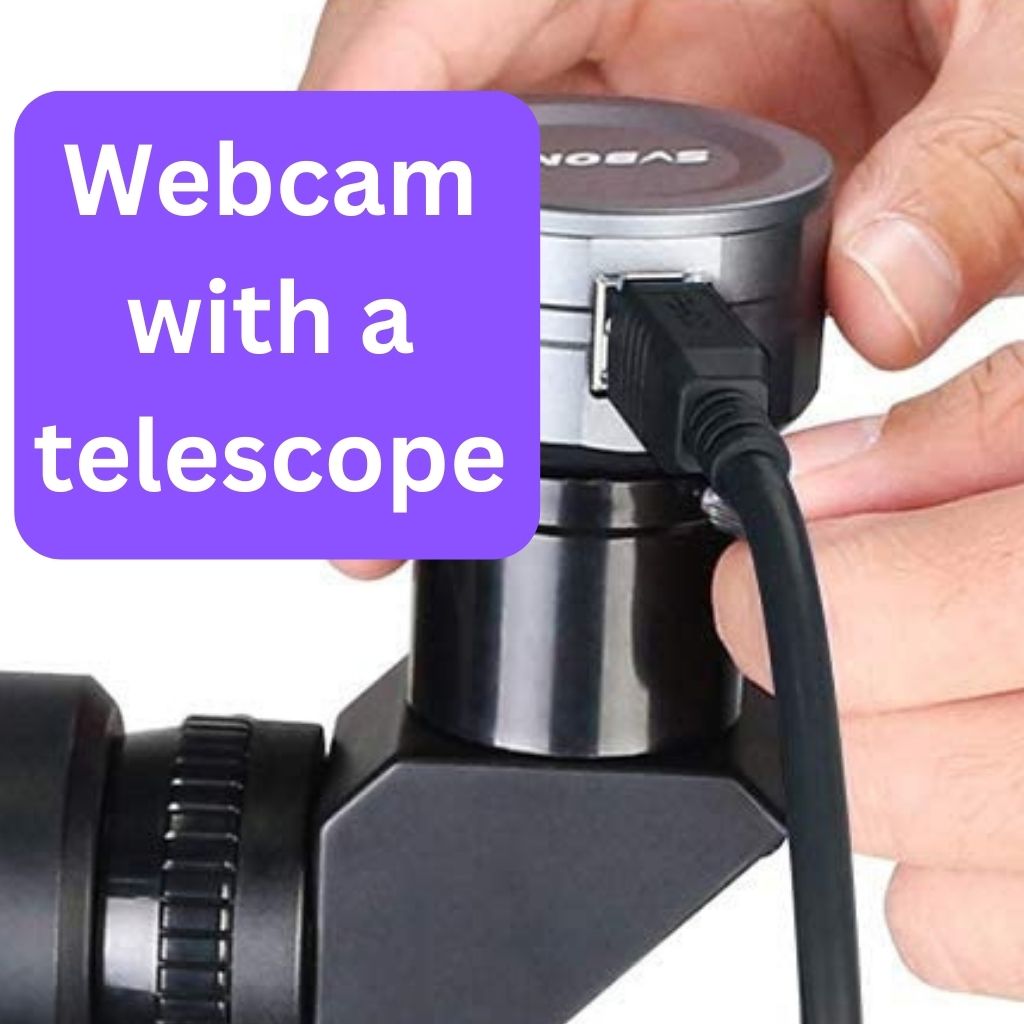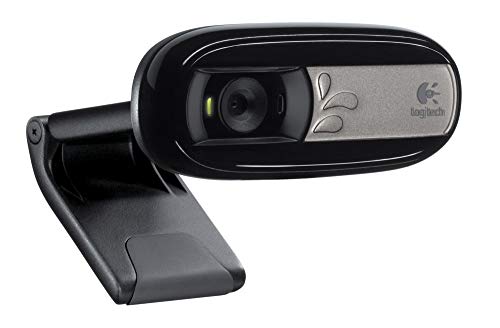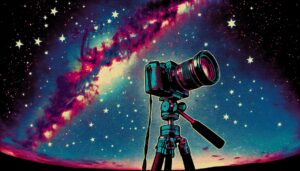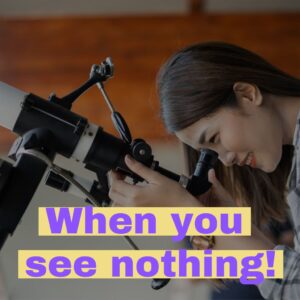This site contains affiliate links to products. I may receive a commission for purchases made through these links.
Using a WebCam with your telescope is the first step to the big topic of Astrophotography and Video Astronomy. Even I had to start with a small 76/700 reflector and a standard webcam.
One benefit of a Webcam telescope is its affordable way to explore the night sky. Using your webcam, you can capture amazing photos and videos of craters on the Moon, Saturn’s rings, or Jupiter with his Moons, planets, stars, and galaxies.
However, many people are unsure how to use a webcam with a telescope, which can be overwhelming for beginners. Nevertheless, don’t skip this experience because it will give you a lot, and you’ll be prepared for the next level.
You can use pretty much any webcam, but you have to modify it by removing some parts to get it working with the telescope.
In this article, I will guide you in setting up a webcam telescope and taking pictures and videos of celestial objects.
Let’s begin!

Types of cameras for astrophotography
Astrophotography is a unique field requiring specialized equipment to capture stunning night sky images. Typically, three main options are available, as shown below.
DSLR cameras
For capturing deep-sky objects, DSLR cameras are one of the best options for photographing deep-sky objects. They can be attached to your telescope with a T-adaptor, and the camera itself can be outfitted with a variety of lenses for landscape astrophotography projects.
Several technical settings and advanced controls are required to complete the task. Rather than connecting the camera to a telescope, connecting a camera lens to the DSLR is required for a wide-field view of space. Long exposure is also possible with DSLRs, but most cameras are expensive.
Webcam
If you want to photograph planets, webcams and dedicated astronomy cameras are the way to go. Although webcams won’t help much in capturing deep-sky objects such as nebulae, galaxies, and globular clusters, they are one of the cheapest options for astrophotography.
When using a webcam for astrophotography, some modifications are necessary. You’ll need a 1.25″ adapter and a Barlow lens to attach the webcam to your telescope.
While long exposures are not typically possible with webcams, they can be modified to suit your needs, and you’ll be amazed by what they can capture.
ZWO
These specialized cameras are designed specifically for astrophotography and come with their own lenses and adapters. They are similar to webcams, requiring a PC or laptop to connect to.
ZWO cameras come in color and monochrome versions, each with benefits. They are capable of long exposure and DSO imaging, but the monochrome versions can capture more details in a single exposure.
However, it requires longer exposure times to produce color images. Prices for ZWO cameras vary from affordable to quite expensive.
How to modify a webcam for use with a telescope?
To use a webcam with a telescope for astrophotography, you need to modify it first. It’s important to note that once you’ve modified it, you won’t be able to use it with a computer anymore, so it’s best to use an old webcam or purchase one specifically for this purpose.
That said, follow the steps below to adapt webcam for telescope.
- The first step in modifying a webcam is to remove the lens. This may require some force, but be careful not to break it. The goal is to have a “naked sensor” without the lens.
- Next, remove the IR cut filter that every camera has. This will allow the camera to capture more details on the objects by seeing IR light. The IR cut filter is a small piece of glass above the sensor and can be removed on some cameras easily, while on others, it may require some effort.
If you need help with how to modify a webcam, don’t worry. I will give you a list of recommended webcams that are easy to modify and attach to the telescope.
Here is a picture of my webcam modified for the telescope. It is an old HP Webcam HD-2200.
You may also like: How To Connect Telescope To Computer
How to hook up a webcam to a telescope?
Fitting a webcam to a telescope can be a tricky thing. There are two ways to do it.
The first and easiest way is to purchase a webcam adapter to a telescope eyepiece holder that can be used with webcams which I will give you a list of later.
One such webcam to telescope adapter is the Solomark Webcam Adapter, which can be screwed onto the webcam and inserted into the focuser like any eyepiece.
The advantage of this adapter is that it has a built-in threaded part so you can attach any filter to enhance the view of the Moon or the planets, unlike the free second option.
The second and free option is a DIY telescope webcam.
If you can find an old 35mm film case, you can use it to attach the camera to your telescope. These cases have the exact dimensions to fit in a 1.25″ eyepiece holder.
You have to be creative with connecting the case to the webcam because it will be different with each camera. Use duct tape or make a precise hole on the bottom to fit the webcam.
Look at the image below; you can see my solution, which works perfectly. The black tape on the case is there because I broke it during the process.
What is the best telescope to use with a webcam?
Using a webcam with a telescope is more complex than just attaching the camera to any telescope. While technically, any telescope can be used; the practical aspect comes into play with the mount to which the telescope is attached.
This is because when you attach the webcam to your telescope, the magnification becomes very high, similar to a 5-6mm eyepiece, depending on the telescope’s focal length.
This high magnification causes a problem with the field of view, making it small and difficult to find and keep small objects in view, especially with a basic telescope on a simple mount.
This means that with a cheap and simple mount, you will be limited to viewing only big objects like the Moon, which slowly leaves the field of view due to Earth’s rotation.
To see planets with a webcam, you need a better mount. Planets appear very small in the sky, and finding small objects with high magnification is quite challenging.
Even if you manage to find them, they will be gone from your view quickly. Moreover, using a webcam requires good focusing skills, or else the object will be blurred and almost invisible.
To improve your focusing skill, practice moving the focuser in and out to find a little spot where the object will be in focus. It is a good practice to try it on some small distant items or trees or something like that during the day.
That said, let’s get back to the point here.
For planets, you need a more advanced mount, either a sturdier one with slow-motion adjusting knobs and your skill to find and keep the planet in view or a motorized GoTo mount that will automatically find and track the planet for you.
Without that, trying to hunt for planets with a webcam will likely be a frustrating experience.
What are the best webcams to convert for telescope?
To excel in astrophotography, the quality of your equipment plays a crucial role, and telescopes are undoubtedly a significant part of it. However, the most critical aspect that can significantly impact the outcome of your capture is your webcam.
Selecting a high-quality telescope deep sky webcam is essential to capture crystal-clear images of celestial objects.
To assist you in your selection, below are the recommended webcams you can convert for use with a telescope.
Many people have tested the webcams on this list, and they work perfectly with a telescope. But most importantly, they are easy to modify, and you can use the Solomark Webcam Adapter to attach them to any telescope.
If you need help modifying the webcam, you can find a lot of tutorials on the internet on how to modify them.
Here are the recommended webcams:
Orion StarShoot USB Eyepiece Camera II.
If you are lazy and don’t have the time or the will to modify or search for the recommended cameras, there is one easy solution for you.
You can actually buy webcams that are made for use with the telescope. Something like this Orion StarShoot. It is a standard webcam, but it’s already modified for you. It is a plug-and-play device where everything you need is a telescope and a computer.
SVBONY SV305 Telescope Camera
This SVONOBY planetary camera is a top webcam telescope eyepiece on the market. It has a back-illuminated CMOS sensor, which makes it extremely sensitive. It comes with a 128MB DDR Buffer to prevent image loss, an ROI function for arbitrary resolutions, and is compatible with c-lenses.
The IMX290 sensor has a very high QE and a very low read noise (0.7e-), which improves sensitivity in the visible and near-infrared light regions for industrial applications.
It has a 1.25” extension tube, user manual, cleaning cloth, and C-lens adapter. It also has a max FPS of 130fps and works with Linux and Windows OS.
Astromania SGCMOS Series Telescope
The Astromania SGCMOS series telescope CMOS camera is designed for astrophotography and features a high-performance CMOS sensor for capturing clear images. It uses USB 2.0 for data transfer and has a built-in ST4 auto guider port for easy connection.
The camera has an aluminum CNC housing with a standard 1.25-inch interface for telescope eyepieces and a standard C-mount for industrial lenses.
It also has a Native/ASCOM/WDM driver for easy connection with 3rd party astrophotography software, making it ideal for capturing images of the Moon, Planets, Galaxies, Clusters, and Nebulae.
Whether or not you use it with a complex Schmidt-Cassegrain or a refractor telescope, this pocket-sized webcam is an excellent choice.
Logitech C170 webcam for telescope
The Logitech C170 webcam is very easy to modify with an adapter. Its flexible design allows for precise image capturing and adjustment.
This webcam delivers high-quality photos with a true resolution of 640×480 and 11.3MP interpolation. It also features a focal length of 2.3mm and can take snapshots of up to 5 megapixels.
Microsoft LifeCam Studio 1080p HD Webcam
Microsoft LifeCam is an HD telescope webcam eyepiece and an excellent choice for astrophotography when paired with the right adapter and Barlow lens. Its features allow you to take high-resolution JPEGs or export videos as AVI.
One of its standout features is TrueColor technology which automatically adjusts image parameters in real time, improving contrast and color vividness for a crystal-clear image.
Benefits of webcam astrophotography
The following are the benefits of webcam astrophotography:
- Cost-effective option: Webcams are cheaper than cameras designed for astrophotography. They are a low-risk and cost-effective way to test your interest in astrophotography, and no film costs are involved. They provide great value for their price.
- Real-time feedback: Webcams allow for adjusting focus and exposure on the fly. This results in better-quality images.
- Single unique image and fast image downloads: Each webcam video imaging session generates a single unique image. Webcams use USB plug-and-play technology, making it easy to install and download images faster.
- Auto-guiding capabilities: With the best webcam telescope software, webcams can be used as auto-guiders for other forms of astrophotography.
- Digital-friendly images and a high number of exposures: Webcam images can be printed, posted online, or emailed without developing or scanning them. They can also take more individual exposures in a single evening of lunar photography than a standard camera.
- Electronic shutter and color images: Webcams have an entirely electronic shutter. This gives them an advantage over standard cameras. Besides black-and-white cameras, webcam images are in color, eliminating the need to combine tri-color images for lunar and planetary work.
- Animated images and movies: Webcams can create animated videos and images of variable events, such as transits of Jovian Moons or lunar occultations of planets and bright stars.
How to capture video with a webcam mounted on the telescope?
To capture video with a webcam mounted on the telescope, you need to install software on your computer that gives you complete control over the camera. This includes controlling the brightness, contrast, exposure, and colors in real-time.
Without these controls, you’ll only see a bright dot when pointing the webcam at planets and an overexposed Moon.
While some webcam software may include these live settings, it’s best to use software specifically designed for use with telescopes like SharpCap if you have a Windows computer or Open Astro Project on a Mac.
Astronomers commonly use this software because it allows them to control everything from there. The SharpCap is used not only with the webcam but also for astrophotography. Although it can be a learning curve, plenty of tutorials are available on YouTube.
If you find SharpCap too complicated, use commercial webcam software like YouCam or BandiCam. Both software options work great for me.
You may also like: Why I Can’t See Anything Through My Telescope?
How to take photos with a webcam and telescope?
So, you saw pictures of the Moon and planets with a webcam, but when you try to take a snapshot with your webcam, it looks nothing close to that? This is because these webcam telescope pictures were processed by stacking many frames from the video footage. This method by which the images are made with a telescope and any camera is called processing.
To achieve this, you will need software that can stack frames from the video. The software I’m using to create images from the video is called Registax, but if you have a Mac, use Lynkeos.
With this software, you can open the video, and in a few steps, it will create a fantastic image by stacking hundreds or thousands of the best frames from your video. This process can make a big difference in the final image quality, giving you more detail than a single, fuzzy frame.
I recommended shooting all videos in the avi format to ensure the best results since Registax works best with it.
Although the process may require a bit of study to master, I won’t explain the whole process here. It is for another article; alternatively, you can find it on YouTube.
Can you use your smartphone with a telescope?
You can use your smartphone with a telescope to capture images and videos of the night sky. It is convenient because almost everyone owns a phone with a good camera today.
You don’t need a computer to capture video or images with your phone. You only need Universal Cell Phone Adapter Mount to attach the phone to your telescope.
An excellent Universal Cell Phone Adapter Mount I recommend is Gosky Universal Cell Phone Adapter Mount.
However, it would help if you also had the eyepiece in the focuser to capture what you can see with the eye in the eyepiece. While you can get almost the same results as with a webcam, the webcam is still a better option for capturing the Moon and planets.
Here is a short video I captured with the iPhone 5 and Celestron Astromaster 130EQ to get an idea of what kind of results you can expect.
Takeaway: Unleash your inner astrophotographer with a webcam telescope
Using a webcam with a telescope is a cost-effective and easy way to capture fantastic night sky images. Even novice astronomers can enjoy the magic of astrophotography with a webcam.
Once you have mastered capturing and image processing using the recommended software, you can move on to more advanced techniques, such as Video astronomy and astrophotography, to capture deep sky objects.
Nonetheless, starting with a webcam or smartphone is a great way to begin your astrophotography journey. The feeling of accomplishment from taking your first photo of the Saturn rings or a close-up of the Moon’s craters will be awe-inspiring.
Join other astronomy enthusiasts by subscribing to our newsletter. Dive into a world of fascinating celestial events, in-depth space analysis, and special offers tailored just for you. Become part of our cosmic community today!
You may also like:











